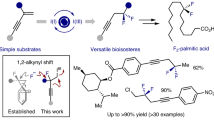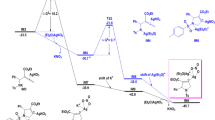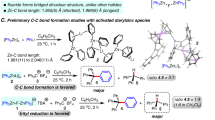Abstract
The primary objective of this work is to delve into the intricacies of allylic fluorination reactions through the application of density functional theory (DFT) calculations. These reactions hold significant importance in the realm of synthesizing organofluorine compounds. The specific focus lies on comprehending the interaction mechanisms when styrenes, a class of organic molecules, come in contact with an electrophilic fluorinating reagent known as Selectfluor. Notably, this interaction pathway demonstrates remarkable efficiency in yielding allylic fluoride products. The proposed mechanism for this transformation involves a sequential process. To unveil the microcosmic intricacies governing this reaction between the alkene substrate and Selectfluor, advanced computational methodologies are employed. The paper systematically outlines the computational strategies harnessed to probe the minute details of the reaction mechanism. The outcomes of these computations are subsequently subjected to thorough analysis, encompassing crucial facets such as transition states and energy barriers. This analytical depth enhances the fundamental understanding of the reaction mechanism and sheds light on the underlying factors influencing its feasibility and efficiency. In a broader context, the insights garnered from this study carry significant utility. They provide pivotal guidance for the optimization of reaction conditions, facilitating the fine-tuning of experimental setups. Moreover, the elucidated mechanism serves as a platform for the design of even more efficient and selective allylic fluorination reactions. This paper, by amalgamating theoretical insights with practical synthetic objectives, contributes to the broader advancement of organofluorine compound synthesis and allied fields.








Similar content being viewed by others
Data availability
This declaration is not applicable.
References
Purser S, Moore PR, Swallow S, Gouverneur V (2008) Fluorine in medicinal chemistry. Chem Soc Rev 37:320–330. https://doi.org/10.1039/B610213C
Press NJ, Joly E, Ertl P (2019) Natural product drug delivery: a special challenge? Prog Med Chem 58:157–187. https://doi.org/10.1016/bs.pmch.2019.01.001
Ertl P, Altmann E, McKenna JM (2020) The most common functional groups in bioactive molecules and how their popularity has evolved over time. J Med Chem 63:8408–8418. https://doi.org/10.1021/acs.jmedchem.0c00754
Gillis EP, Eastman KJ, Hill MD, Donnelly DJ, Meanwell NA (2015) Applications of fluorine in medicinal chemistry. J Med Chem 58:8315–8359. https://doi.org/10.1021/acs.jmedchem.5b00258
Wang J, Sánchez-Roselló M, Aceña JL, del Pozo C, Sorochinsky AE, Fustero S, Soloshonok VA, Liu H (2014) Fluorine in pharmaceutical industry: fluorine-containing drugs introduced to the market in the last decade (2001–2011). Chem Rev 114:2432–2506. https://doi.org/10.1021/cr4002879
Kirk KL (2006) Fluorine in medicinal chemistry: recent therapeutic applications of fluorinated small molecules. J Fluorine Chem 127:1013–1029. https://doi.org/10.1016/j.jfluchem.2006.06.007
O’Hagan D (2008) Understanding organofluorine chemistry. An introduction to the C-F bond. Chem Soc Rev 37:308–319. https://doi.org/10.1039/B711844A
Ogawa Y, Tokunaga E, Kobayashi O, Hirai K, Shibata N (2020) Current contributions of organofluorine compounds to the agrochemical industry. iScience 23:101467. https://doi.org/10.1016/j.isci.2020.101467.
Jeschke P (2004) The unique role of fluorine in the design of active ingredients for modern crop protection. ChemBioChem 5:570–589. https://doi.org/10.1002/cbic.200300833
Cheong PH-Y, Legault CY, Um JM, Çelebi-Ölçüm N, Houk KN (2011) Quantum mechanical investigations of organocatalysis: mechanisms, reactivities, and selectivities. Chem Rev 111:5042–5137. https://doi.org/10.1021/cr100212h
García-Melchor M, Braga AAC, Lledós A, Ujaque G, Maseras F (2013) Computational perspective on Pd-catalyzed C-C cross-coupling reaction mechanisms. Acc Chem Res 46:2626–2634. https://doi.org/10.1021/ar400080r
Cheng G-J, Zhang X, Chung LW, Xu L, Wu Y-D (2015) Computational organic chemistry: bridging theory and experiment in establishing the mechanisms of chemical reactions. J Am Chem Soc 137:1706–1725. https://doi.org/10.1021/ja5112749
Bernardi F, Bottoni A, Garavelli M (2002) Exploring organic chemistry with DFT: radical, organo-metallic, and bio-organic applications. Quant Struct-Act Relat 21:128–148. https://doi.org/10.1002/1521-3838(200207)21:2%3c128::AID-QSAR128%3e3.0.CO;2-B
Nakliang P, Yoon S, Choi S (2021) Emerging computational approaches for the study of regio- and stereoselectivity in organic synthesis. Org Chem Front 8:5165–5181. https://doi.org/10.1039/D1QO00531F
Katcher MH, Norrby P-O, Doyle AG (2014) Mechanistic investigations of palladium-catalyzed allylic fluorination. Organometallics 33:2121–2133. https://doi.org/10.1021/om401240p
Hagelin H, Åkermark B, Norrby P-O (1999) A solvated transition state for the nucleophilic attack on cationic η3-allylpalladium complexes. Chem Eur J 5:902–909. https://doi.org/10.1002/(SICI)1521-3765(19990301)5:3%3c902::AID-CHEM902%3e3.0.CO;2-W
Frisch MJ, Trucks GW, Schlegel HB, Scuseria GE, Robb MA, Cheeseman JR, Scalmani G, Barone V, Petersson GA, Nakatsuji H, Li X, Caricato M, Marenich AV, Bloino J, Janesko BG, Gomperts R, Mennucci B, Hratchian HP, Ortiz JV, Izmaylov AF, Sonnenberg JL, Williams, Ding F, Lipparini F, Egidi F, Goings J, Peng B, Petrone A, Henderson T, Ranasinghe D, Zakrzewski VG, Gao J, Rega N, Zheng G, Liang W, Hada M, Ehara M, Toyota K, Fukuda R, Hasegawa J, Ishida M, Nakajima T, Honda Y, Kitao O, Nakai H, Vreven T, Throssell K, Montgomery Jr. JA, Peralta JE, Ogliaro F, Bearpark MJ, Heyd JJ, Brothers EN, Kudin KN, Staroverov VN, Keith TA, Kobayashi R, Normand J, Raghavachari K, Rendell AP, Burant JC, Iyengar SS, Tomasi J, Cossi M, Millam JM, Klene M, Adamo C, Cammi R, Ochterski JW, Martin RL, Morokuma K, Farkas O, Foresman JB, Fox DJ (2016) Gaussian 16 Rev. C.01. Gaussian 16 Rev C01, Gaussian, Inc, Wallingford CT
Geerlings P, De Proft F, Langenaeker W (2003) Conceptual density functional theory. Chem Rev 103:1793–1874. https://doi.org/10.1021/cr990029p
Tomasi J, Persico M (1994) Molecular interactions in solution: an overview of methods based on continuous distributions of the solvent. Chem Rev 94:2027–2094. https://doi.org/10.1021/cr00031a013
Miertuš S, Scrocco E, Tomasi J (1981) Electrostatic interaction of a solute with a continuum. A direct utilizaion of AB initio molecular potentials for the prevision of solvent effects. Chem Phys 55:117–129. https://doi.org/10.1016/0301-0104(81)85090-2
Fukui K (1981) The path of chemical reactions - the IRC approach. Acc Chem Res 14:363–368. https://doi.org/10.1021/ar00072a001
Singh A, Goel N (2015) Regioselective nucleophilic aromatic substitution reactions of 5,7-dinitroquinazoline-4-one and 5,7-dinitroquinazoline-4-thione with methylamine: a mechanistic consideration. New J Chem 39:4351–4358. https://doi.org/10.1039/C5NJ00291E
Grimme S (2006) Semiempirical GGA-type density functional constructed with a long-range dispersion correction. J Comput Chem 27:1787–1799. https://doi.org/10.1002/jcc.20495
Luo H-Q, Loh T-P (2009) Synthesis of aryl allylic fluorides by direct electrophilic fluorination of alkenes. Tetrahedron Lett 50:1554–1556. https://doi.org/10.1016/j.tetlet.2009.01.052
Saini V (2022) A machine learning approach for predicting the fluorination strength of electrophilic fluorinating reagents. Phys Chem Chem Phys 24:26802–26812. https://doi.org/10.1039/d2cp03281c
Chauhan N, Singh H, Singh KN, McKenna JM, Saini V (2022) Development, synthesis, and in silico investigations of novel acyclic allyl fluoride derivatives. Synthesis 55:837–845. https://doi.org/10.1055/a-1961-8013
Salem L (1968) Intermolecular orbital theory of the interaction between conjugated systems. I. General theory J Am Chem Soc 90:543–552. https://doi.org/10.1021/ja01005a001
Salem L (1968) Intermolecular orbital theory of the interaction between conjugated systems. II. Thermal and photochemical cycloadditions. J Am Chem Soc 90:553–566. https://doi.org/10.1021/ja01005a002
Fukui K (1971) Recognition of stereochemical paths by orbital interaction. Acc Chem Res 4:57–64. https://doi.org/10.1021/ar50038a003
Houk KN (1975) Frontier molecular orbital theory of cycloaddition reactions. Acc Chem Res 8:361–369. https://doi.org/10.1021/ar50095a001
Fukui K (1982) The role of frontier orbitals in chemical reactions (Nobel Lecture). Angew Chem Int Ed Engl 21:801–809. https://doi.org/10.1002/anie.198208013
Houk KN, Munchausen LL (1976) Ionization potentials, electron affinities, and reactivities of cyanoalkenes and related electron-deficient alkenes. A frontier molecular orbital treatment of cyanoalkene reactivities in cycloaddition, electrophilic, nucleophilic, and radical reactions. J Am Chem Soc 98:937–946. https://doi.org/10.1021/ja00420a012
Sauer J, Sustmann R (1980) Mechanistic aspects of Diels-Alder reactions: a critical survey. Angew Chem Int Ed Engl 19:779–807. https://doi.org/10.1002/anie.198007791
Yu J, Su NQ, Yang W (2022) Describing chemical reactivity with Frontier molecular orbitalets. JACS Au 2:1383–1394. https://doi.org/10.1021/jacsau.2c00085
Fukui K, Yonezawa T, Shingu H (2004) A molecular orbital theory of reactivity in aromatic hydrocarbons. J Chem Phys 20:722–725. https://doi.org/10.1063/1.1700523
Rozeboom MD, Tegmo-Larsson IM, Houk KN (1981) Frontier molecular orbital theory of substitutent effects on regioselectivities of nucleophilic additions and cycloadditions to benzoquinones and naphthoquinones. J Org Chem 46:2338–2345. https://doi.org/10.1021/jo00324a026
Zhuo L-G, Liao W, Yu Z-X (2012) A Frontier molecular orbital theory approach to understanding the Mayr equation and to quantifying nucleophilicity and electrophilicity by using HOMO and LUMO energies. Asian J Org Chem 1:336–345. https://doi.org/10.1002/ajoc.201200103
Acknowledgements
Useful resources from the Department of Chemistry, Panjab University, are sincerely acknowledged.
Funding
This work was supported by Department of Science and Technology, Ministry of Science and Technology, India (Grant number – [DST/INSPIRE/04/2017/002529]).
Author information
Authors and Affiliations
Contributions
V. S.: conceptualization, methodology, software, supervision, writing—original draft, reviewing and editing, validation, visualization, project administration, resources H. S.: software, data curation, software, writing- original draft, reviewing and editing, validation, visualization, resources.
Corresponding author
Ethics declarations
Ethical approval
We did not perform any experiments when preparing this article, so neither ethics review nor informed consent was necessary.
Competing interests
The authors declare no competing interests.
Additional information
Publisher's Note
Springer Nature remains neutral with regard to jurisdictional claims in published maps and institutional affiliations.
Supplementary Information
Below is the link to the electronic supplementary material.
Rights and permissions
Springer Nature or its licensor (e.g. a society or other partner) holds exclusive rights to this article under a publishing agreement with the author(s) or other rightsholder(s); author self-archiving of the accepted manuscript version of this article is solely governed by the terms of such publishing agreement and applicable law.
About this article
Cite this article
Singh, H., Saini, V. A mechanistic investigation of metal-free allylic fluorination of styrenes for the synthesis of allyl fluoride derivatives using density functional theory. Struct Chem (2023). https://doi.org/10.1007/s11224-023-02253-6
Received:
Accepted:
Published:
DOI: https://doi.org/10.1007/s11224-023-02253-6




